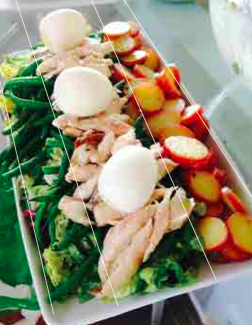
It has often been said that we eat first with our eyes. Whether we actively think about it or not, our senses play an important role in the food we choose to eat, even before we take our first bite. A simple breast of chicken served poached and pale becomes far more appealing when presented with a beautiful browned skin or aesthetically pleasing grill marks. A platter of hors d’oeuvres, a simple salad or sliced raw vegetables with dip become much more appealing when artfully arranged as opposed to just scattered on a plate. Most of us have been served a plate that we have deemed “too pretty to eat,” because when skillfully presented, food can become a work of art.
Thanks to the invention of the iPhone, savvy diners can be seen surreptitiously snapping photos of beautifully plated food in restaurants everywhere. Most everyone from discriminating chefs to freestyle foodies find a beautifully plated dish, the overwhelming abundance of produce at a local farmers market or a fishmonger’s display of the freshest fish to be a beautiful thing worthy of snapping a picture. The balance of color and texture on a plate greatly adds to the appeal of any dish. Cleverly placed sauces and delicate shreds of herbs or colorful spices create accents and eye appeal not unlike an artist creating a beautiful painting. The straight lines found in the most beautiful architecture can also be used in plating design to create an interesting way of presenting food.
You don’t have to be the executive chef in a fine restaurant to create beautifully plated food at home. Here are some tips.
Color: Mix up colors and try not to put two colors directly together on a plate. If you are serving a white fish such as cod or halibut, don’t choose a white starch such as rice or potatoes. A sunny yellow polenta or colorful pasta like bright red pepper or rich squid ink would add a more interesting contrast. The more variety in the color of foods being served, the more attractive the meal.
Texture: Serving foods of similar textures or consistencies
can become very boring. Try not to overcook vegetables when roasting or sautéing. Garnish plates with finishing touches like toasted pine nuts, crispy fried shallots or a julienne of fresh vegetables for contrast in texture.
Flavor: Draw out, enhance or balance the flavor of a dish by including fruit to balance a spicy dish or adding roasted garlic or truffle oil to pasta or mashed potatoes. The final addition of crunchy salt like fleur de sel or Maldon makes flavors pop, and a drizzle of fine olive oil adds flavor as well as visual appeal.
Plating design: Choose plates that showcase the food. Plates of attractive colors and shapes add charm and allure. If the plate is too small, too large or if too many components are used, the appearance of the dish can get muddled. If foods are too close together, elements of the dish can get lost. When plating food be sure not to leave too much space between food items. Begin with a base such as a sauce, pasta or rice. Then select a focal point and build from that part of the presentation.
These simple tips can help you turn plating designs into works of art. You may have your guests pulling out their iPhones to snap photos at your next dinner party!
On a recent vacation to Spain and France, I had the opportunity to shop at the local markets to create a meal for our friends in Marseilles. With nothing particular in mind, we perused the market to see what looked appealing. The fish I chose came directly from the sea and is commonly called “dorado” in Spain. While some may know dorado as mahi mahi, this particular fish refers to dorada, a gilthead sea bream found in the Mediterranean. They have a gold stripe down their side hence “dorada,” meaning golden. I chose to fillet the fish as the focal part of my dish and build from there by creating a fumet from the bones and heads. After placing a portion of the fumet in a bowl, I used oven-roasted Romanesco as my base and topped that with the crispy pan-fried fish. I crowned the fish with a fresh salad of shaved fennel and orange segments and drizzled the plate with a fruity olive oil.
The second course was my simple version of Salad Nicoise (classically made with tuna, potato and haricot verte, French green beans). I artfully plated it by separating the ingredients to add contrast and interest to the platter. In place of the traditional tuna, I gently poached some local mackerel in olive oil with bay leaf, garlic and herbs, and tossed the lettuces and boiled fingerling potatoes in lemon and olive oil. My gift to our host turned out to be spectacular!
Lisa Glickman is a private chef and teacher who lives in Portland. She has made TV appearances on COTV in Central Oregon and appeared on the Cooking Channel’s “The Perfect Three.” She can be reached at lisa@lisaglickman.com.





